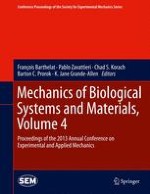2014 | Buch
Mechanics of Biological Systems and Materials, Volume 4
Proceedings of the 2013 Annual Conference on Experimental and Applied Mechanics
herausgegeben von: François Barthelat, Pablo Zavattieri, Chad S. Korach, Barton C. Prorok, K. Jane Grande-Allen
Verlag: Springer International Publishing
Buchreihe : Conference Proceedings of the Society for Experimental Mechanics Series
